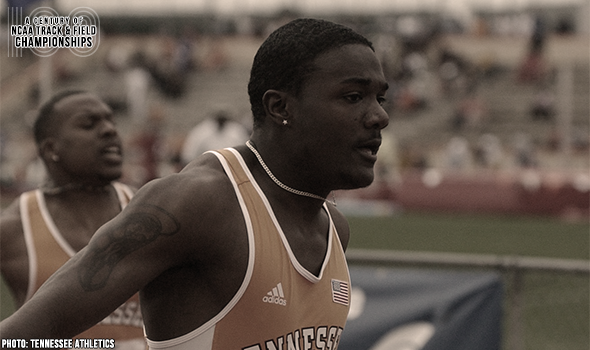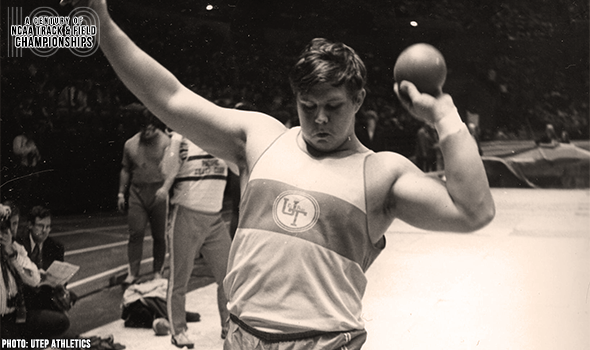
Stanford Romped To National Title in 1928
How good was Stanford’s 1928 NCAA championship team?
The Cardinal’s 72 points more than doubled the total of its closest challenger.
Stanford also had five different athletes win individual titles: That’s a combination no other program has yet matched in the same meet.
Adding to the impressiveness, all five of the Cardinal’s individual champions that year were (or would become) world record setters and/or Olympic medalists, and no points were scored by a sixth athlete with that same illustrious distinction.
Bud Spencer was captain of the squad and scored Stanford’s only points on the track, winning the 440 yards in a meet record 47.7. Spencer, who had broken the 400-meter world record at 47.0 a month earlier, had the fastest split on the U.S. 4×400 quartet that won gold with a world record in the 1928 Olympics later that summer.
Also setting a meet record – two, in fact – was pole vaulter Ward Edmonds with a final height of 13-6½ (4.13m). Earlier in the year, Edmonds had equaled the world record and became history’s third-ever 14-footer. Edmonds, who in 1929 became the first repeat NCAA vault champion with a co-title (and another MR at 13-8¾ or 4.18m), died suddenly in 1930 from polio at age 22.
Robert King won the high jump at 6-4½ (1.94m) and afterward was allowed to continue jumping, scaling a PR 6-6½ (1.99m). A month later, King would only need just 6-4¼ to earn the gold medal at the Olympics in Amsterdam.
Stanford could have won the meet just in the throwing events, where they earned 34 points (team runner-up Ohio State had 31), led by sophomore Eric Krenz with 18.
It was Krenz who actually got Stanford’s celebration started early, setting a meet record in the discus qualifying on the first day. His MR 149-2 (45.48m) carried over the next day to win the final and he added a runner-up effort in the shot put, losing to teammate Harlow Rothert.
For Rothert, another sophomore, it was the first of three-straight shot put titles to become the meet’s first three-time champion in a field event (Krenz was second each time). Both throwers were Olympians, though only Rothert would earn a medal – silver in the shot put in 1932, by which time teammate Krenz – a three-time world record setter in the discus – had died in a boating accident at age 25.
Not even scoring for Stanford was Ross Nichols, who finished sixth in the 120-yard hurdles but was disqualified for knocking over a hurdle. A month later, Nichols earned a similar DQ in the Olympic Trials 110-meter hurdles, in which he equaled the world record of 14.8 in the semifinals without knocking over any barriers.
The NCAA and collegiate track & field will mark a momentous milestone in the spring of 2021 -- the 100th anniversary of the NCAA Championships and with that, the NCAA Track & Field Championships. In June 1921, the University of Chicago hosted the first track & field championships in NCAA history.
This point can’t be emphasized enough: Not only was the event the first for NCAA track & field, but the first championships for any sport under the sponsorship of the NCAA.
To celebrate, over each of the next 365 days, the U.S. Track & Field and Cross Country Coaches Association (USTFCCCA) will celebrate moments, student-athletes, and coaches that have made a century’s worth of championships special. From humble beginnings to important historical milestones to the modern-day, collegiate track & field has evolved with the American society.
The 2021 edition of the NCAA Division I Outdoor Track & Field Championships begin with preliminary round action on May 27-29 in Jacksonville, Fla., and College Station, Texas. The championships final site and culmination of the celebration is slated for June 9-12, 2021 at the newly rebuilt Hayward Field in Eugene, Ore.

Providence’s Smith Left Field In The Dust
Kim Smith won the 5000 meters at the 2004 NCAA Division I Outdoor T&F Championships by 36.04 seconds in 15:48.86 for the largest margin of victory in meet history.

Gatlin Doubled Up In Back-To-Back Years
Justin Gatlin completed back-to-back 100-200 doubles at the NCAA DI Outdoor T&F Championships in 2001 & 2002. He went 10.08/20.11 & 10.22/20.18 in those respective years.

UTEP’s Hoglund First To Crack 70-Foot Barrier
Hans Hoglund was the first man to touch the 70-foot barrier in the SP at the NCAA DI Outdoor T&F Championships. He also won by more than 4 feet with his 21.33m (70-0) heave in 1975.

LSU’s Hobbs Couldn’t Be Caught In 2018
Aleia Hobbs anchored LSU to a 4×100 relay MR of 42.25 & then doubled back to win the 100 by 0.23 seconds at the 2018 NCAA DI Outdoor T&F Championships.

Michael Johnson Had 1990 NCAAs To Remember
All eyes were on Michael Johnson of Baylor in the 4×400-meter relay at the 1990 NCAA Division I Outdoor Track & Field Championships.

Riley Completed Unprecedented Double In 2012
Andrew Riley completed the only 100-110H double in NCAA DI Outdoor T&F Championships history in 2012. Riley won the 100 in 10.27 & then captured the 110H crown in 13.53

Leatherwood Rolled To Back-To-Back 400 Titles
Lillie Leatherwood won back-to-back 400-meter titles at the NCAA Division I Outdoor T&F Championships in 1986 & 1987. She set a meet record of 50.90 in that second year.

Iowa’s Jones Made Distance History
Charles “Deacon” Jones set a meet record in the 2-mile at the 1957 NCAA Outdoor Track & Field Championships with his time of 8:57.6.

Locke Doubled Up On Sprint Titles In 1926
Roland Locke entered the 1926 NCAA Outdoor T&F Championships as the WR holder in the 220. He left with the meet record in that event (20.9) & also won the 100 in 9.9.

McLain Bounded To All-Conditions TJ Best
Erica McLain won the triple jump at the 2008 NCAA DI Outdoor Track & Field Championships by nearly two feet! McLain bounded to an all-conditions meet best at 14.60m (47-11).

